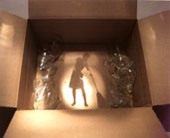- Exhibition program
- Cycle: Invisible Circles
- Artist
- Heidi Kumao
- Dates
- —
- Curated by
- Ferran Barenblit
We all have memories that are difficult to recall clearly. Our mind functions in a somewhat enigmatic way, retaining certain things, forgetting others, and almost all of them are stored in a curious sign language that we find hard to explain and into which we often feel it better not to delve. Formed in part during our childhood, our memory holds images of home and of our early experiences of life.
These reminiscences are the starting point for Heidi Kumao’s work. In a room that is as dark and mysterious as our mind, her pieces have fleeting images as their protagonists. These figures, projected on to the walls of the Espai 13, are like telegraphic memories, ephemeral messages sent from our selective memory which we now have to reconstruct.
Her work refers to those things that happen in our most immediate surroundings. They are often situations that are difficult to accept and involve a certain order of society that we received in our infancy. The interpretation, however, also depends on the viewer’s memory and what these images suggest to him or her. The implicit violence to be found in some of them may have different meanings for different people. Kumao thus makes a play between the need to decode our own memory and the need to interpret a work of art.
The economy of means she uses is significant. Technically, her work is based on the zoetrope, a precursor of the motion picture that enables images in movement to be reproduced in a very rudimentary way. This apparatus is combined with items from our daily domestic lives that recall the physical and psychological environment to which she continually refers. They also allow her to show "how things work", through the devices and the spectacle that they generate.
Works included in Nervous System: Adore, 1995; Decoy, 1997; Every hour on the hour, 1996; Kept II, 1998; Learning to swim, 1997-98; Tied: a Duet, 1993.


